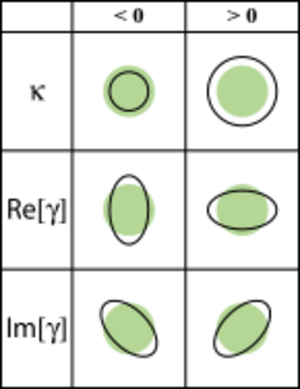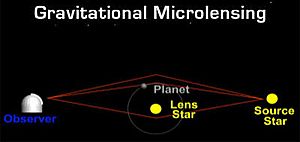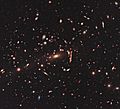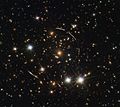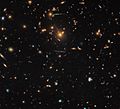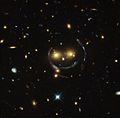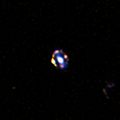Gravitational lensing facts for kids
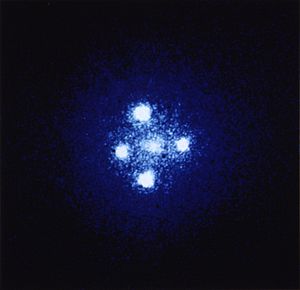
Gravitational lensing happens when a huge object, like a galaxy or black hole, is between us and something far away in space. This big object has a very strong pull, called a gravitational field. This pull bends the light coming from the distant object.
Because the light bends, it can make one distant object look like two or more! It's like looking through a wonky glass. How much the light bends depends on how far away things are, the size of the big object, and how much stuff (mass) is inside it.
Contents
How Gravity Bends Light
A famous scientist named Albert Einstein first thought that gravity could bend light. This idea was part of his general theory of relativity. Scientists later proved he was right!
They watched how light from distant stars bent when it passed close to our Sun. This bending showed that Einstein's theory was correct. It was a big discovery!
Types of Gravitational Lensing
There are three main ways gravitational lensing can happen:
- strong lensing
- weak lensing
- microlensing
Strong Lensing: Seeing Double (or More!)
Strong lensing is when you see many images of the same object. It's like looking into a funhouse mirror that makes many copies. A great example is called Einstein's Cross. This is a quasar that is 8 billion light-years away.
A galaxy sits in front of it, about 400 million light-years away. The galaxy's gravity bends the quasar's light. This makes us see four separate images of the same quasar! The light does not travel in a straight line to Earth.
The first time scientists saw this (besides the Sun's effect) was in 1979. They saw two quasars that looked very close. They found out these were actually two images of the same quasar. In 1980, they found the group of galaxies that was acting as the lens.
Weak Lensing: Stretched and Squashed Images
Weak lensing does not make many images of one object. Instead, it makes the distant object look stretched or squashed. Imagine looking at something through a slightly wavy window.
Scientists first saw this in 1986 in a group of galaxies called Abell 370. They realized a very stretched image was actually a galaxy far behind the cluster.
Weak lenses can also make distant objects look bigger or brighter. This is super helpful! It lets us see galaxies that are very far away and usually too faint to spot. The bending light gathers more light from the distant galaxy, making it visible to our telescopes.
Microlensing: Finding Hidden Planets
Microlensing is different. It does not change the shape of an object. Instead, it makes the amount of light from an object change over time. This change can help us find planets outside our solar system, called exoplanets.
Here is how it works: Light from a distant star gets bent and brightened by the gravity of a closer star. If that closer star has an exoplanet orbiting it, the planet's tiny gravity will cause extra, small bends in the light. This makes the distant star's light get brighter and dimmer in a regular pattern.
The first exoplanet found this way was OGLE-2005-BLG-390-Lb. It was discovered on 25 January 2006.
Images for kids
-
A light source passes behind a gravitational lens (invisible point mass placed in the center of the image). The aqua circle is the light source as it would be seen if there were no lens, while white spots are the multiple images of the source (see Einstein ring).
-
One of Eddington's photographs of the 1919 solar eclipse experiment, presented in his 1920 paper announcing its success
-
Detailed look at a gravitationally lensed type Ia supernova iPTF16geu.
-
"Smiley" image of galaxy cluster (SDSS J1038+4849) & gravitational lensing (an Einstein ring) (HST).
-
Abell 1689 - actual gravitational lensing effects (Hubble Space Telescope).
-
Dark matter distribution - weak gravitational lensing (Hubble Space Telescope).
-
Gravitational lens discovered at redshift z = 1.53.
See also
 In Spanish: Lente gravitatoria para niños
In Spanish: Lente gravitatoria para niños


